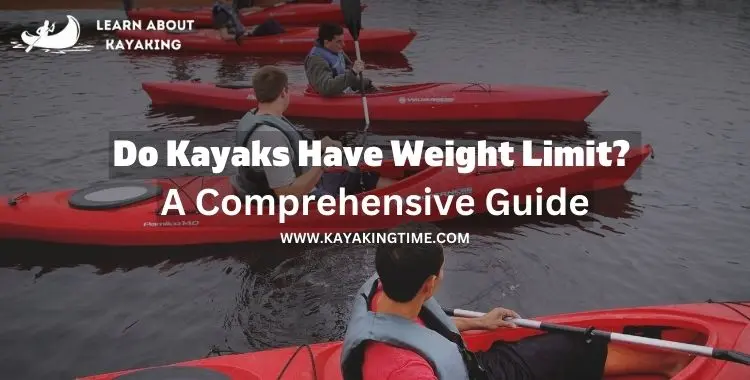is kayak dangerous? Read this before its too late!
Have you ever tried kayaking? It’s super cool! Kayaking is an exciting outdoor activity that lets you discover nature’s splendor and push your physical and mental limits. Just imagine you get to be out in nature, surrounded by beautiful waters, and feel like a real explorer. Isn’t it amazing?
But, like any beginner eager to try kayaking, you might find yourself wondering, Is kayaking dangerous?
Well, just like any other exciting sport, kayaking has its own risks. But don’t worry, with some safety smarts, we can have a blast and stay safe at the same time. It’s important to know what to look out for, especially if you’re not a great swimmer or new to paddling.
So, in this article, we’re going on a journey to discover the answers! We’ll talk about the common dangers, learn about safety measures, and figure out how to make our kayaking adventures super fun and secure.
So, before further a do, Let’s get started!
Is Kayak Dangerous?
Yes, kayaks can be dangerous, and for those who don’t know how to use them properly or forget to take simple precautions while paddling, it can even be deadly.
To stay safe, it’s essential to try kayaking only in areas where you have the necessary experience. But remember, some risks can still pop up even in calm waters. That’s why it’s important to be organized and well-informed before setting out on any kayaking adventure.
By following safety guidelines and getting the right knowledge, you can enjoy kayaking while keeping yourselves and your friends safe.
Evaluating the perceptions and reality about the dangers of kayaking
Before we jump into the world of kayaking and how to ensure a safe adventure, let’s explore an interesting concept, perceived risk versus actual risk.

Perceived risk means how dangerous we think a situation is, while actual risk refers to the real level of danger present. Let’s imagine, paddling near the shore on a calm, small lake or canal. Generally, kayaking is considered safe when we avoid extreme weather conditions.
On the other hand, navigating through whitewater rapids in a kayak does come with a certain level of risk, no matter how skilled we are. It’s essential to recognize this significant risk!
Here’s something fascinating: many extreme sports, like kayaking, are often seen as riskier than they truly are when we follow proper safety measures. But you know what’s great? When we perceive a higher risk, it motivates us to be extra cautious and prioritize safety over unnecessary risks.
So, let’s embrace this higher perceived risk as it will inspire us to take all the necessary precautions for a fun and secure kayaking experience!
Common Kayaking Danger – Kayaking Risk Assessment
Here are some potential dangers of kayaking that you should be aware of before you hit the water. Some of the common kayaking dangers are:
1- Inappropriate Equipment
Using inappropriate or faulty equipment can increase the risk of boating accidents and injuries. It is crucial to ensure that all equipment, such as life Jackets, paddles, and safety gear are in good working condition and suitable for the specific water activity.
Regular maintenance and equipment inspections are essential to ensure their effectiveness and reliability.
2- Sun Exposure
Prolonged sun exposure while boating can lead to sunburn, heatstroke, and dehydration. To protect against sun exposure, wearing sunscreen with a high SPF, protective clothing, and a hat is important.
Staying hydrated by drinking plenty of water and seeking shade when necessary can also help prevent heat-related illnesses.

3- Dehydration
Dehydration can occur when the body loses more fluids than it takes in, leading to fatigue, dizziness, and decreased cognitive function.
To prevent dehydration while boating, drinking plenty of water before, during, and after the activity is important.
However, avoiding alcohol and caffeinated beverages, which can contribute to dehydration, is also recommended.
4- Hypothermia and Cold Shock
Hypothermia occurs when the body loses heat faster than it can produce, leading to a dangerously low body temperature.
On the other hand, cold shock refers to the initial shock experience when entering cold water, which can cause involuntary gasping and potentially lead to drowning.
To prevent hypothermia and cold shock, it is important to wear appropriate clothing for the water temperature, such as wetsuits or dry suits.
Additionally, knowing how to enter cold water correctly and acclimatizing gradually can help reduce the risk of cold shock.
5- Adverse Weather Conditions
Boating in adverse weather conditions, such as strong winds, thunderstorms, or fog, can be hazardous. It is crucial to check weather forecasts before heading out and to be prepared to postpone or cancel the boating trip if severe weather is expected.
A reliable means of communication, such as a marine radio or cell phone, can also help in emergencies.
6- Waves, Tides, and Currents
Waves, tides, and currents can pose significant risks to boaters, especially in open water or near coastal areas.
It is important to be aware of the local conditions and to have a good understanding of how waves, tides, and currents can affect the boat’s stability and maneuverability.
It is essential to avoid areas with strong currents or rough waves and know how to navigate them safely.
7- Weirs/Low-Head Dams
Weirs or low-head dams can create dangerous hydraulic conditions that can trap and drown boaters. It is important to know the location of weirs or low-head dams and avoid boating near them.
If boating in areas with such structures, it is crucial to stay well away from the downstream side and to follow any posted warnings or guidelines provided by local authorities.
8- Capsizing
Capsizing refers to overturning a boat or watercraft, which can lead to potential dangers and accidents.
Precautions to prevent capsizing include:
- Ensuring proper weight distribution in the boat.
- Avoiding sudden movements or shifts in weight.
- Being aware of the boat’s maximum weight capacity.
Additionally, wearing life jackets and knowing how to swim can significantly reduce the risk of injury or drowning in the event of a capsizing.
9- Strainers and Sweepers
Strainers and sweepers refer to natural obstacles in the water, such as fallen trees or branches, which can trap or sweep boaters away.
It is important to be vigilant and avoid areas with potential strainers or sweepers. If encountered, it is crucial to steer clear of them and, if necessary, to use proper techniques, such as leaning away from the obstacle, to avoid entrapment.
10- Drinking and Paddling
Consuming alcohol or drugs while boating can impair judgment, coordination, and reaction time, increasing the risk of accidents and injuries.
It is important to avoid drinking or using drugs while operating a boat or participating in water activities. Designating a sober operator or using alternative means of transportation can help ensure the safety of everyone on board.
11- Wildlife
Wildlife encounters while boating pose risks, especially if the animals feel threatened or if they are in their mating or nesting season.
If you encounter any shark or alligator, observe them from a safe distance and avoid approaching or disturbing them. Always check for any specific wildlife regulations or guidelines in the area you are going to kayak.
12- Getting Lost
Getting lost while boating can be a serious concern, especially in unfamiliar or remote areas. Having a navigational plan and being familiar with the waterways you will be boating in is important.
Carrying a map, compass, or GPS device can help prevent getting lost. Additionally, informing someone of your boating plans and estimated return time can provide extra safety.
13- Exhaustion
Boating can be physically demanding, especially during long trips or in rough conditions. Be aware of your physical limits and taking breaks when needed, is important.
Staying hydrated, eating nutritious snacks, and getting enough rest before boating can help prevent exhaustion.
It is also important to have a backup plan if you become too tired to continue boating safely.
14- Undercut Rocks
Undercut rocks are rocks that have eroded underneath, creating a dangerous undercut or overhang. These can be hazardous to boaters as they trap or capsize a boat.
It is important to be aware of the presence of undercut rocks and to avoid them. It is crucial to navigate around them and maintain a safe distance if encountered.
15- Sports-Related Injuries
Engaging in water sports or recreational activities while boating can increase the risk of sports-related injuries.
Following safety guidelines and using proper equipment for the specific activity is important. Wearing helmets, life jackets, and other protective gear can help prevent injuries.
16- Lack of Experience
Lack of experience is the primary risk in kayaking, as it is responsible for over a fifth of kayaking deaths in 2020. To avoid this risk, it is essential to choose a route that matches your ability.
Advanced paddlers can tackle rough waves on open water and class IV rapids, but beginners should join a kayaking class to learn control and practice wet exits and capsize recoveries.
As you progress, check your routes with experienced paddlers and avoid kayaking alone.
17- Other Boating Traffic
Sharing the water with other boaters can pose risks, especially in crowded or busy areas.
It’s important to be aware of other boating traffic and to follow boating rules and regulations, such as maintaining a safe distance and yielding the right of way when necessary.
Keeping a lookout for other boats and using proper signaling and communication can help prevent collisions and accidents.
So, they were some common dangers we should consider while kayaking for enjoying this unforgettable adventure.
Video Guide – Kayak Safety Rules for Beginners
How to avoid kayaking dangers
Avoiding kayaking dangers is all about being prepared and following some simple rules. Let’s go over some essential tips to keep you safe on the water:
1- Kayak with a Friend
Kayaking with a friend is not only more fun, but it also provides extra safety. You can watch out for each other and help in case of an emergency.
2- Do not Drink and paddle
Refrain from drinking and paddling as it can lead to catastrophic outcomes and is illegal.
3- Keep an emergency kit
Keep an emergency kit that includes a communication device in an emergency. Also bring a whistle, flashlight, and a first-aid kit in your kayak. It’s always good to be prepared for unexpected situations.
4- Wear Appropriate Kayaking bathing suits
Dress for the weather and water temperature. If it’s cold, wear layers and gear suitable for kayaking in chilly conditions.
5- Learn basic safety skills
Learn basic safety skills like paddling stroke, rolls, and self-rescue techniques to prevent accidents.
6- Wear life jacket
Always, always, always wear a properly fitting life jacket. It keeps you afloat and safe, even if you accidentally fall into the water.
7- Stay Close to the Shore
If you’re a beginner, stick to calm, shallow waters and stay close to the shore. As you gain experience, you can venture further.
8- Choose the right location
Choose a location suitable for your experience and skill level.
9- Inform someone before going kayaking
Share your kayaking plans and file a float plan with someone close. So if you are not back on time they will start searching for you.
10-Check weather conditions
Before heading out, check the weather forecast. Avoid kayaking during storms or when strong winds are expected.
Is sea kayaking dangerous
Sea kayaking is such a thrilling adventure and with the right preparation and safety measures, you can totally enjoy sea kayaking safely.
So, here are a few things to keep in mind when sea kayaking
1- Open Water
Sea kayaking usually happens in wide-open waters, which can have stronger currents and bigger waves compared to calm lakes or rivers.
2- Distance from Shore
Depending on where you are, you might be quite far from the shore while sea kayaking. That means it could be harder to reach safety if something unexpected happens.
3- Weather Conditions
The sea can be a bit unpredictable, and the weather can change fast. Strong winds, big waves, and storms might make sea kayaking a bit challenging and even a little risky.
4- Navigation
Sea kayaking might require some navigation skills. You’ll need to know where you are and plan your route to avoid any hazards.
5- Cold Water
In some places, the water can be pretty chilly. So, if you end up in the water, there’s a higher risk of getting really cold, which is not good.
But don’t worry! There are simple things you can do to stay safe and have a blast sea kayaking
How to avoid Sea kayaking dangers
- Always check the weather forecast before you head out and avoid going if the conditions look bad.
- Wear a life jacket at all times, and if the water is cold, consider using a wetsuit or drysuit to stay cozy.
- It’s always a good idea to paddle with a buddy or a group. You’ll have more fun together, and you can help each other out if needed.
- Want to be extra prepared? Take a kayaking course to learn all the essential skills and safety techniques.
By being prepared, knowing what to expect, and being careful, you can have an incredible time sea kayaking without taking unnecessary risks. Enjoy the open waters and make unforgettable memories!
Is kayaking safe for beginners
No, It’s not safe for beginners. But it doesn’t mean that they can not experience this wholesome activity, they can go kayaking on Any water with calm and slow-moving water currents.
Beginners can enjoy kayaking while taking some precautions and proper guidance. Also with beginner-friendly kayaks, safety equipment, and training programs, beginners kayakers can discover the joys of kayaking without any trouble.
Also, consider taking a kayaking course to learn the basics and advanced techniques. Knowledge is power, and it helps you handle different situations confidently.
So, by sticking to basic safety guidelines and following the advice of experienced kayakers, beginners can safely explore the calm waters and gain confidence to navigate more challenging conditions.
Conclusion – is kayak dangerous
So, is kayaking dangerous? How well we evaluate and manage the risks at play will determine our response. The good news is that kayaking can be an enjoyable and safe activity for everyone if we take the right precautions.
It’s essential to do a comprehensive risk assessment, understand the potential disadvantages, and use proper safety measures.
This is particularly important for non-swimmers or those who are new to paddling. With the right preparation and safety measures, anyone can safely enjoy the excitement of kayaking.
Don’t let the potential dangers deter you from this thrilling water sport. Instead, be informed and prepared to have a fantastic and secure kayaking experience!
After reading this article, I hope you’ve gained valuable insights about the dangers of kayaking. As I strive to present accurate and helpful information.
Stay safe and have a blast out there on the water!
FAQs – is kayak dangerous
q. What are essential safety Equipment?
Essential safety equipment for kayaking includes a PFD, whistle/signaling device, bilge pump/sponge, paddle float, spray skirt, and navigation lights (for night kayaking).
q. What should i do when my kayak flips while kayaking ?
If your kayak flips, remain calm, stay with the kayak, attempt self-rescue, use a paddle float, and signal for help if needed.
q. When should you not kayak?
You should not kayak during severe weather, strong currents/rough waters, poor visibility, or if you have health concerns.
q. Can i go for kayaking at night?
Kayaking at night is riskier due to poor visibility and potential collisions with hazards. Priority and safety equipment are essential.
q. How do you know if it is safe to kayak?
To determine if it is safe to kayak, consider weather/water conditions, skill level, safety equipment, and local regulations.
q. Is a sit-on-top kayak safer?
Sit-on-top kayaks are generally safer for beginners and recreational paddlers due to their stability and ease of re-entry and self-rescue.
q. Is kayaking alone safe or not?
Kayaking alone can be safe with proper precautions, including experience, knowledge of the area, good paddling skills, informing someone of your plans, wearing a PFD, and carrying essential safety equipment. However, kayaking with a partner or group is generally considered safer.
q. Can non-swimmers go kayaking?
Yes, non-swimmers can go kayaking! While being a non-swimmer can add some challenges, with proper precautions, kayaking can still be a safe and enjoyable activity.






